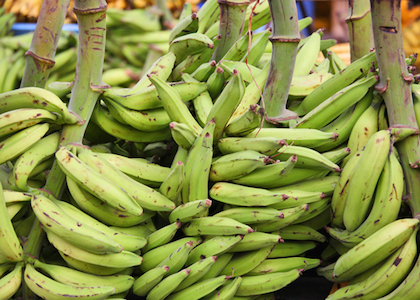
A Fiber We Can’t Resist
By Claire Georgiou, Reboot Naturopath, B.HSc ND
I couldn’t resist talking about resistant starch (RS)! Why? Well, it’s a type of starch that’s been considered to be the third type of fiber found in food, and just may help your weight loss goals in many ways!
What is RS?
This type of starch passes through the stomach and small intestine undigested. It is not accessible and can’t be digested, therefore it acts as a fiber. When the resistant starch reaches the large intestine (colon) it is then broken down and fermented by the bacteria in the large bowel..
There are 3 types of naturally occurring RS:
Type 1: This starch is bound by fibrous cell walls found naturally in legumes, seeds and grains.
Type 2: High amylose containing foods in its raw state such as potatoes, unripe (green) bananas and plantains; once they are cooked the starch becomes accessible.
Type 3: This is when type 1 & 2 are cooked then cooled.
Helps Support Weight Loss
One of the reasons this fiber is such a benefit, is because it helps us lose and maintain weight loss.
1. Improved fiber consumption from RS helps hunger levels and positively effects hunger hormones and satiety.
2. Resistant starch offers fewer calories in place of higher calorie containing foods of similar weight.
3. Improves glycemic effect by improving insulin sensitivity and blood sugar control. This study showed that the consumption of 15-30 grams per day of resistant starch showed improved insulin sensitivity in overweight and obese people by up to 50%.
4. Improves glycemic effect of the next meal. The next meal you eat, consumed after consumption of the RS, has less of a blood sugar increase and insulin effect.
5. Reduces fat storage in fat cells and increases fat oxidation, particularly post weight loss.
6. Support and maintenance of healthy bowel microbes.
Foods High in RS
Foods high in resistant starch are unripe (green) bananas, plantains, legumes (particularly white beans, black beans, chickpeas, green peas, lentils and kidney beans), cashews, oats, oatmeal, wholemeal pasta, pearl barley, rice, yams and potato.
These foods may be cooked but they must be cooled before consumption to be high in RS. They must be consumed in their whole form unprocessed only as the processing allows the starch to be completely accessible.
How Does RS Work?
Once resistant starch reaches the large colon it selectively acts as a food for the healthy bacteria found in our large bowel. When the good bacteria consume the RS it produces short chain fatty acids that support the health and integrity of our bowel cells.
These short chain fatty acids are also beneficial as:
- Natural anti-inflammatory agents within the body
- They help support nutrient absorption
- They reduce re-absorption of metabolic wastes in the bowel
- Inhibit the growth of pathogenic (bad) bacteria
RS has shown promise in studies to reduce the risk of colorectal cancer due to these effects.
Some research also indicates that obese people may have a different bacterial population compared with leaner persons. There is some evidence that healthy bacteria play a role in the maintenance and health of our metabolism.
Poor microbial health is highly associated with chronic health conditions such as obesity, inflammatory bowel disease, depression, anxiety, infections and poor immunity.
It is clear that diet can have a major influence positively or negatively on microbial proliferation and community both in the short and long term thus effecting our overall health. RS helps to maintain this healthy gut flora.